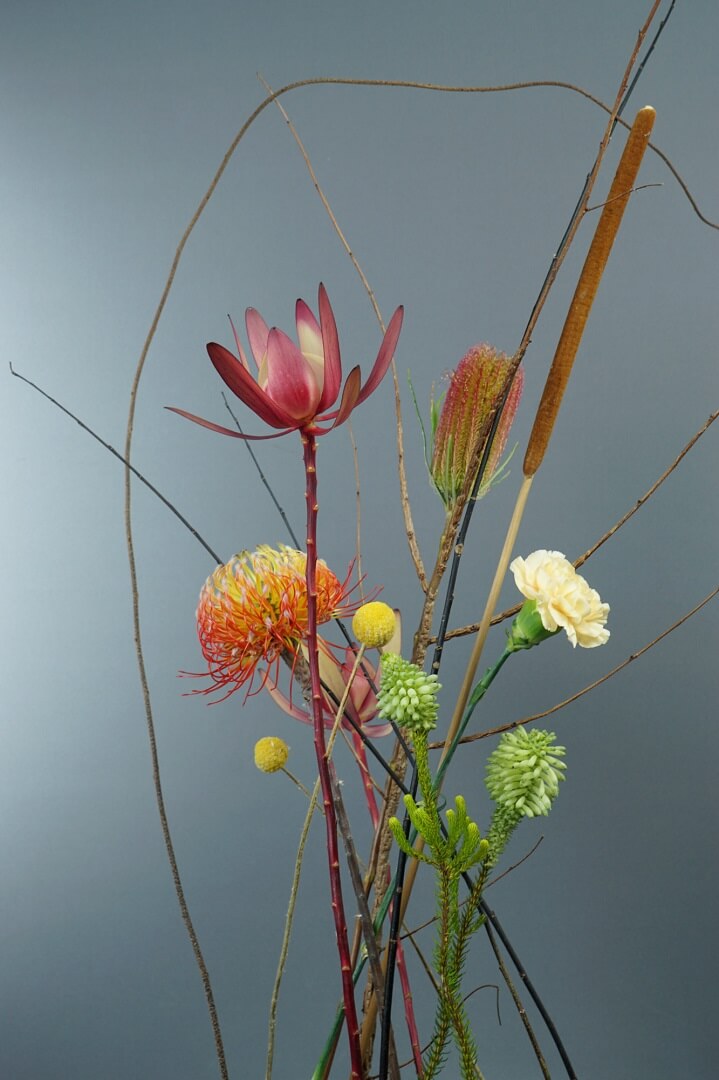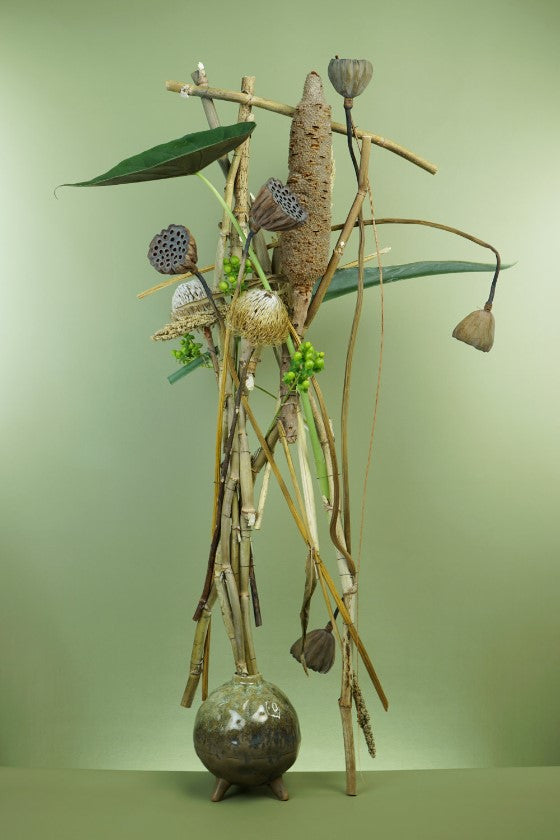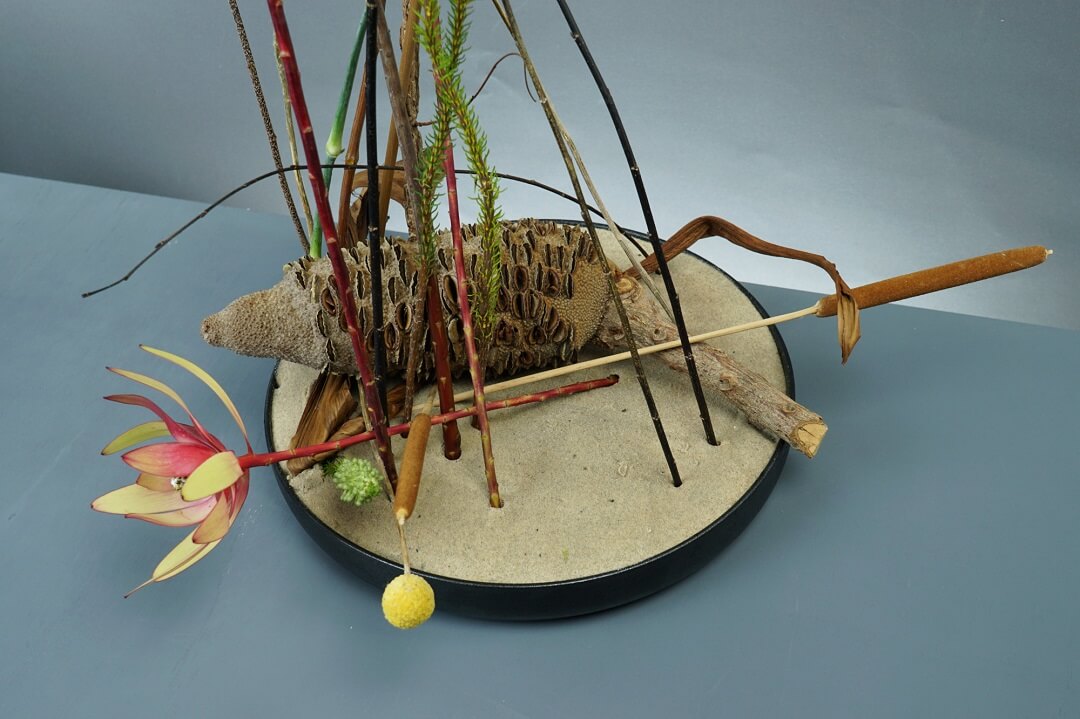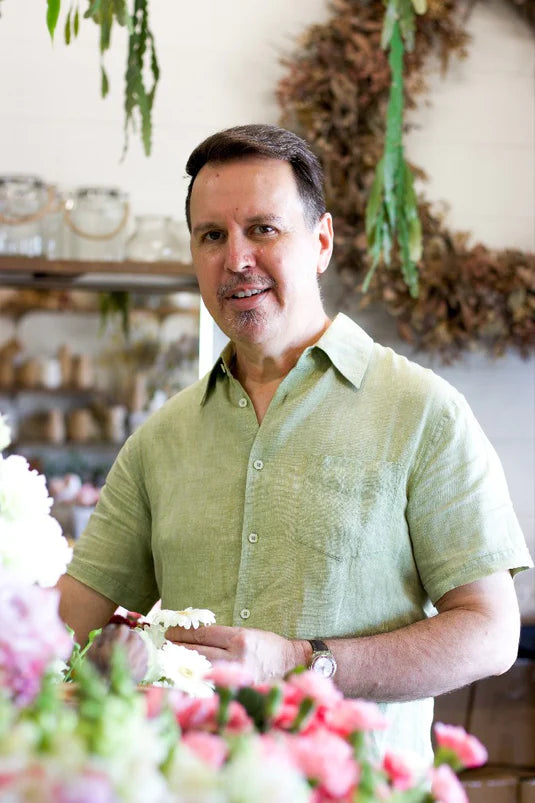
Advanced Directions - A Deeper Exploration of the Principles of Design
See Course Dates
Advanced Directions stretches our design skills by putting a spotlight on combinations of principles that aren't frequently encountered.
A must if you are looking to improve your designing and challenge yourself to trying out new ideas.
Yet another amazing floral learning opportunity by our incredible Mark Pampling and Flower Thinking. The experience of learning is outstanding with endless learning opportunities. This is not simply an online course, it is an interactive extremely detailed, deep learning opportunity. Thank you Flower Thinking - My designs from the course are pictured below. So much learning and adaptation creates a new awareness and thought process in design which I truly enjoyed.

For most of our creative lives, especially commercially and classically, we tend to work, mostly, in a comfort zone of symmetrical, radial, and decorative styles.
We don't often encounter the opportunity to combine systems of designing that really challenge our way of thinking.

How often do we create an asymmetrical formal-linear design with an overlapping line system?
Exploring this combination of design possibilities can bring a new appreciation of achieving effective visual balance while working with limited materials.

Working in shallow depth offers the chance to experiment with the distribution of space and mass, which is usually more of a challenge when the contrast between the dimensions is strong.

How often do we create shallow, horizontal designs using a consistent parallel system to organise the materials?
This exercise can increase our visual acuity in placing and aligning flowers.

Experimenting with downward directed proportions provides opportunities to improve the creation and distribution of focal areas whilst moving the eye effectively through the length of a design.

By focusing on specific combinations of principles for each task, we create clear direction for working, allowing you to create within common parameters for the benefit of shared learning – gaining better understanding by reviewing a range of submitted work for each task.
-

The most enjoyable part was seeing all the participants' designs and getting together in the meetings when you would give your feedback.
-

The actual analysing of the students' work and in particular the way you describe why and how you achieved your challenge in the chosen design.
-

Mark's feedback - I think it was detailed, I loved the written report.

You don't need a big flower budget to complete the tasks. Resourcefulness is encouraged.
Advanced Directions is as much about the process by which we arrive at our designs as it is about the designs themselves.

I often just use what I have in my garden, or what I find growing by the roadside.
Although the three fern designs shown here are from Design Solutions rather than Advanced Directions, they illustrate the point that you do not need an abundance of material choice to create impact in floral design.

Fern, Dual Urn Design
Design created as a class example for Design Solutions.
Nephrolepis exaltata (Boston fern)
Design - Mark Pampling
Photography - Mark Pampling

Advanced Directions is delivered as a set of five online meetings, with four practical tasks. The online discussions can be joined live and/or viewed as recordings.
Each task is followed by a live online discussion, based on floral design theory.
Taking the work that you've submitted before each meeting, Mark prepares detailed, considered feedback framed within the terms of the principles of design.
Advanced Directions Timetable
|
2024
Online Introduction Meeting #1 - Monday 22 July 2024, 6:00pm
Subsequent Online Discussions Meeting #2 - Monday 5 August 2024, 6:00pm
Meeting #3 - Monday 26 August 2024, 6:00pm
Meeting #4 - Monday 16 September 2024, 6:00pm
Meeting #5 - Monday 14 October 2024, 6:00pm
Course dates for 2025 are yet to be announced. Times All times listed are Australian Eastern Daylight Time (AEDT - Sydney). You can compare your local time zone to Sydney time at flowerthinking.com/worldtime. |
Stay Updated
If you'd like us to update you on new course dates and other developments in Advanced Directions, you can register your interest here.
Participation Guide
The Participation Guide is your guide to getting the most out of your participation in the Advanced Directions program.
If you have questions about Advanced Directions, some answers may be found in it, and you are also welcome to ask us any question directly.

Mark Pampling has been designing, competing, teaching and judging for thirty years now and is as well known for his clear, linear design style as for his patient and inclusive way of sharing his knowledge.
- 2019 Beijing World Flower Art Contest – Champion
- 2015 Interflora World Cup, Berlin – Judge
- 2014 Fusion Flowers International Designer of the Year – 1st Place
- 9th China International Orchid Show (Sanya) – Best Creative Award
- 2014 International Flower Contest Japan – Best in Show, Gold Award and Design Innovation Award
- Asia Cup 2014 (Japan) – 1st Place – Surprise Table Display
- 2013 Fusion Flowers International Designer of the Year – 2 Silver Awards & 1 Bronze Award
- 2012 Fusion Flowers International Designer of the Year – 4th Place
- 2012 Interflora Australia Cup – Winner
- 2011 Interflora Australia Cup – Winner
- Australian Competitor 10th Interflora World Cup 2004 – 3rd Place
You can learn more about Mark here.
Advanced Directions Online Course
Advanced Directions Online Course
Advance Your Understanding of the Elements and Principles of Floral Design
Running over five months, it's a stimulating, interactive course for Florists, Floral Artists and Floral Designers who are eager to advance their design skills by applying creativity and floral design knowledge to a carefully chosen path.
The program timetable and detailed information on how to participate can be found in the Participation Guide.
Couldn't load pickup availability
Share

Let customers speak for us
from 76 reviewsThe intriguing theme,"Uncommon threads", captured my attention and thinking. I initially thought this short course,"Designing to win", would be too challenging. I found that it was actually comprehensive, well organized and structured, and rewarding eventually. This course was about understanding the rules and schedule of a competition. It was about learning how to evaluate one's design for a competition against an essential list of marking criteria for judging. Mark conducted two virtual discussion forums fluently, meticulously and constructively by giving clear analysis with concise explanations. He posed questions and made suggestions on each participant's design in #1 submission. The task of improving/adjusting/changing in order to achieve a better outcome became the necessary challenge for #2 submission.
The learnings from all the other submissions was just as important as those of mine. After having completed this course, I gained a better understanding of the entire process of designing to win and the crucial decision making that hinged on the points/marks for judging. The "wow factor" which can contribute to winning can be achieved by more critical evaluation of a design. Learning to be a better designer is always my aim in participating in Mark's courses. I truly felt that I achieved it and it was a likely "win" for me. The instructional eBooks and video tutorials on competitions were valuable bonuses given after completion of the course.
Thank you, Mark, for this great opportunity to learn from you.
One Container, Five Elements expanded my design processes and choices. Analysing the container and looking for a link to each of the five elements. Focusing on one element was a disciplined journey, one that became more complex the further I travelled along the path, albeit a rewarding journey. On reflection it allowed me to consider my choices and to give each element of design a voice in my arrangements. I likened it to a choir where one voice may lead but if the supporting harmonies are not in pitch the whole auditory experience is not quite right. I found myself falling to my favourite elements and constantly self-evaluating to see what was often needed, often editing rather than adding. During the group feedback sessions, I gained new eyes not only on my own work but that of my peers. Such a rewarding experience.
Each task or assignment for this course pushes you to think more about placement of components in order to ensure that the elements and principles of design are used to create a harmonious result. Mark encourages creativity by providing examples before leaving you to work in your own way, this is incredibly stimulating. All feedback provided is done in a positive way which encourages you to assess your own work better each time - however I still manage to repeat some of the same faults over and again ;) so plenty more to learn.
I really enjoyed the course and particularly found the critique process really helpful, as Mark carefully explained what worked well with the designs we had each produced and how they could potentially be improved further. At each stage, Mark explained how the design principles applied and helped me to develop my understanding of contemporary work.
Yet another amazing floral learning opportunity by our incredible Mark Pampling and Flower Thinking. The experience of learning is outstanding with endless learning opportunities. This is not simply an online course, it is an interactive extremely detailed, deep learning opportunity. Thank you Flower Thinking - My designs from the course are pictured below. So much learning and adaptation creates a new awareness and thought process in design which I truly enjoyed.
Festive Thinking allowed me to expand my creativity. Mark’s ebooks and video explanations were clear and provided examples of the task. I throughly enjoyed creating with the sickles and the online forum. Mark expert advice and suggestions gives insights into the designer’s arrangements. This allows for self improvement and reflection on my own creation. A wonderful experience I look forward to the next Flower Thinking offering.



